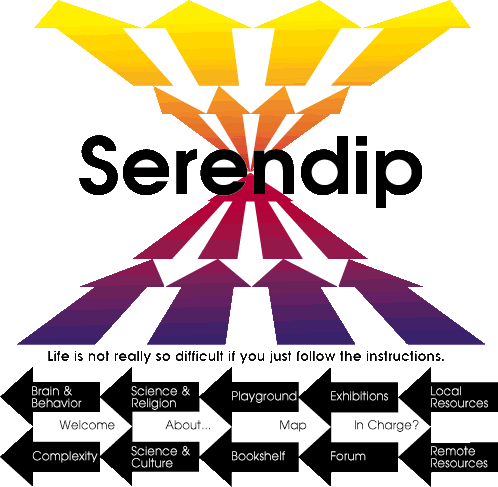Not on a Mountain Top
Serendip unites a commitment to social justice with history, philosophy, and sociology of science in order to interpret the role science plays within society.
Serendip is an independent site partnering with faculty at multiple colleges and universities around the world. Happy exploring!
Serendip unites a commitment to social justice with history, philosophy, and sociology of science in order to interpret the role science plays within society.

This is some serious play. The website is organized around the concepts of play, randomness, and the unfinished. Serendip offers a gathering place for open-ended inquiry into the implications of science and science education.
Serendip delights in facilitating the ongoing exchange of narratives about science between different groups of people or as literary critic Roland Barthes wrote in S/Z, ‘narrative is determined not by a desire to narrate but by a desire to exchange.’ This has led to newer exhibits returning to previous exhibits and then turning to the future. Serendip draws together or toward itself, as much as a website can be a self, open-ended inquiries, develop a higher degree of critical thinking about the role of science education in society.
Please contact us through the form below to propose comments, single page submissions, and pitches for more substantial exhibits that engage with existing materials on the website. Please learn about what Serendip is interested in before contacting us.

Serendip is a digital ecosystem dedicated to gathering people together for the exploration of science and its implications for art, climate change, disability studies, literature, mental health, pedagogy, social justice, and technology.
This is a term of endearment for Serendip. Salmon dip is a homophonic translation, which is to say that it carries over the sound of the word rather than its meaning. This phrase comes out of the belief that self-reflection constitutes some serious play. (Also the origin of the Twitter handle @notsalmondip).

Dear reader, if you only read one point, in this essay, READ THIS ONE. The more diverse a class’s content, the easier it is to reach lots of students. Using the following is greatly appreciated:
Bullet points Bolding important things Blank space between paragraphs Videos Podcasts Phone Calls Zoom meetings Pictures
While there are no magic bullets, the multimodal approach makes a big difference. At the very least, make sure your PowerPoints aren’t black and white, reading on colors is easier for those of us with dyslexia.